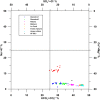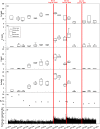Hydrogeochemical changes before and during the 2016 Amatrice-Norcia seismic sequence (central Italy)
- PMID: 28916778
- PMCID: PMC5601465
- DOI: 10.1038/s41598-017-11990-8
Hydrogeochemical changes before and during the 2016 Amatrice-Norcia seismic sequence (central Italy)
Abstract
Seismic precursors are an as yet unattained frontier in earthquake studies. With the aim of making a step towards this frontier, we present a hydrogeochemical dataset associated with the 2016 Amatrice-Norcia seismic sequence (central Apennines, Italy), developed from August 24th, with an Mw 6.0 event, and culminating on October 30th, with an Mw 6.5 mainshock. The seismic sequence occurred during a seasonal depletion of hydrostructures, and the four strongest earthquakes (Mw ≥ 5.5) generated an abrupt uplift of the water level, recorded up to 100 km away from the mainshock area. Monitoring a set of selected springs in the central Apennines, a few hydrogeochemical anomalies were observed months before the onset of the seismic swarm, including a variation of pH values and an increase of As, V, and Fe concentrations. Cr concentrations increased immediately after the onset of the seismic sequence. On November 2016, these elements recovered to their usual low concentrations. We interpret these geochemical anomalies as reliable seismic precursors for a dilational tectonic setting.
Conflict of interest statement
The authors declare that they have no competing interests.
Figures







Similar articles
-
Changes in groundwater trace element concentrations before seismic and volcanic activities in Iceland during 2010-2018.Sci Total Environ. 2021 Nov 1;793:148635. doi: 10.1016/j.scitotenv.2021.148635. Epub 2021 Jun 24. Sci Total Environ. 2021. PMID: 34328979
-
Clock advance and magnitude limitation through fault interaction: the case of the 2016 central Italy earthquake sequence.Sci Rep. 2019 Mar 21;9(1):5005. doi: 10.1038/s41598-019-41453-1. Sci Rep. 2019. PMID: 30899081 Free PMC article.
-
Multi-segment rupture of the 2016 Amatrice-Visso-Norcia seismic sequence (central Italy) constrained by the first high-quality catalog of Early Aftershocks.Sci Rep. 2019 May 6;9(1):6921. doi: 10.1038/s41598-019-43393-2. Sci Rep. 2019. PMID: 31061514 Free PMC article.
-
Dataset of seismic ambient vibrations from the quaternary Norcia basin (central Italy).Data Brief. 2020 May 18;31:105709. doi: 10.1016/j.dib.2020.105709. eCollection 2020 Aug. Data Brief. 2020. PMID: 32514415 Free PMC article.
-
Analysis of the macroseismic cumulative damage in the seismic sequences in Italy.Bull Earthq Eng. 2025;23(2):759-778. doi: 10.1007/s10518-024-02073-x. Epub 2024 Dec 11. Bull Earthq Eng. 2025. PMID: 39896043 Free PMC article. Review.
Cited by
-
Volume unbalance on the 2016 Amatrice - Norcia (Central Italy) seismic sequence and insights on normal fault earthquake mechanism.Sci Rep. 2019 Mar 12;9(1):4250. doi: 10.1038/s41598-019-40958-z. Sci Rep. 2019. PMID: 30862941 Free PMC article.
-
Stable isotopes show that earthquakes enhance permeability and release water from mountains.Nat Commun. 2020 Jun 2;11(1):2776. doi: 10.1038/s41467-020-16604-y. Nat Commun. 2020. PMID: 32488089 Free PMC article.
-
Reaction of the carbonate Sibillini Mountains Basal aquifer (Central Italy) to the extensional 2016-2017 seismic sequence.Sci Rep. 2022 Dec 27;12(1):22428. doi: 10.1038/s41598-022-26681-2. Sci Rep. 2022. PMID: 36575251 Free PMC article.
-
Prediction of contaminant transport in fractured carbonate aquifer types: a case study of the Permian Magnesian Limestone Group (NE England, UK).Environ Sci Pollut Res Int. 2019 Aug;26(24):24863-24884. doi: 10.1007/s11356-019-05525-z. Epub 2019 Jun 25. Environ Sci Pollut Res Int. 2019. PMID: 31240647 Free PMC article.
-
New observations in Central Italy of groundwater responses to the worldwide seismicity.Sci Rep. 2020 Oct 20;10(1):17850. doi: 10.1038/s41598-020-74991-0. Sci Rep. 2020. PMID: 33082507 Free PMC article.
References
-
- Manga, M. & Wang, C.-Y. In Treatise on Geophysics 305–328, 10.1016/B978-0-444-53802-4.00082-8 (Elsevier, 2015).
-
- Cicerone RD, Ebel JE, Britton J. A systematic compilation of earthquake precursors. Tectonophysics. 2009;476:371–396. doi: 10.1016/j.tecto.2009.06.008. - DOI
-
- Reasenberg PA. Foreshock occurrence before large earthquakes. Journal of Geophysical Research: Solid Earth. 1999;104:4755–4768. doi: 10.1029/1998JB900089. - DOI
-
- Aggarwal YP, Sykes LR, Armbruster J, Sbar ML. Premonitory Changes in Seismic Velocities and Prediction of Earthquakes. Nature. 1973;241:101–104. doi: 10.1038/241101a0. - DOI
-
- Jones L, Molnar P. Frequency of foreshocks. Nature. 1976;262:677–679. doi: 10.1038/262677a0. - DOI
Publication types
LinkOut - more resources
Full Text Sources
Other Literature Sources
Research Materials

